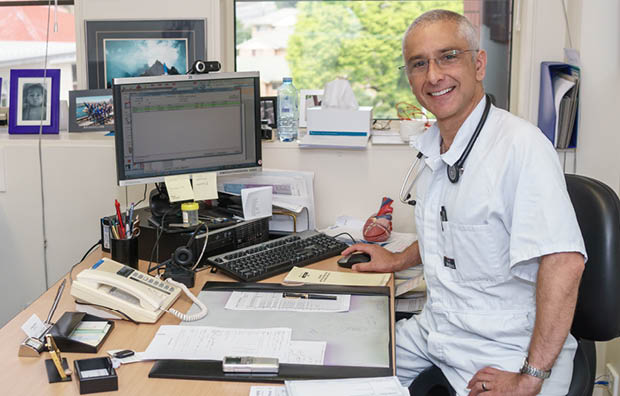HEART DOCTOR’S BOOK EXPLAINS HOW CARDIAC CT SCANS ARE THE BEST WAY TO REVEAL THE SECRET KILLERS…
JOHN McNAMEE TALKS TO ONE OF THE COUNTRY’S LEADING CARDIOLOGISTS ON THE PERILS OF CORONARY ARTERY DISEASE AND HOW IT CAN BE DETECTED IN TIME
When it comes to people surviving serious heart disease, don’t mention the word “miracle” to trail-blazing cardiologist Dr Warrick Bishop.
It’s not that he doesn’t believe in the word, it’s just that he thinks such do-or-die situations should be rectified long before the “miracle” stage.
After all, he says, it’s too late when the only time you learn that a person has a network of clogged arteries and a cholesterol count that’s through the roof, is during the post mortem.
It’s also a bit late when the patient who suddenly has a “heart attack” is in the back of an ambulance heading to the Emergency Department.
The straight-talking medic also explains that “heart attack” is not strictly a medical term … he and his fellow specialists refer to a Major Adverse Coronary Event or MACE as describing a full blockage or near-complete blockage of a coronary artery and its consequences.
Coronary artery disease describes the process of atherosclerosis or plaque build-up in the arteries that leads to impaired blood flow which causes symptoms or loss of function.
Hobart-based Dr Bishop points out that heart disease affects around 1.4 million Australians and is the single leading cause of death in this country. It kills 54 Australians each day or one Australian every 27 minutes.
And according to the Australian Heart Foundation, 55,000 people suffer a “heart attack” each year.
Staggering statistics but according to Dr Bishop, who has been a ground-breaking cardiologist for more than 20 years, this situation can be improved.
He says there is technology there that can isolate and recognise the symptoms of coronary disease long before it gets to the terminal stage.
“Everybody knows about the effectiveness of, for example, mammograms in the early detection of breast cancer but we have similar early warning equipment that can be just as effective and offer patients with heart issues a longer life,” Dr Bishop told Go55s.
He was referring to CT scanning or computed tomography which developed from the original 1980s technology called electron beam computed tomography and during the past two decades has become far more sophisticated.
The information that is obtained through the process of “photographing” the heart and its arteries can identify a patient’s danger build-ups such as the location and nature of plaque and calcium…”in exquisite detail…..information that had previously not been obtainable, non-invasively, in a living patient.”
The process and its dramatic results among a wide range of patients is graphically but entertainingly outlined in a unique book written by Dr Bishop and which has just been published.
Its quite dramatic title is Have You Planned Your Heart Attack? It has been described by some of his patients as “A book to buy for someone you love” and “a book that will save your life.”

It is written in a simple language style with a lot of explanatory case histories making it easy to understand for the laymen.
Dr Bishop takes the theme of “what if we could be forewarned or prepared for a potential problem with our coronary arteries and what if we were able to put in place preventative measures that may avert a problem?
“Taking a picture of the coronary arteries using CT to determine their health isn’t new, it just isn’t being done routinely,” Dr Bishop says.
“Yet, by using these technological advances you can be ahead of the game about your cardiovascular health.
“Wouldn’t you want to know if the single biggest killer in the western world was lurking inside you,” Dr Bishop asks.
In other words, why be a ticking time-bomb when the methodology is available to discover the hidden perils?
Dr Bishop says the CT scanning images the heart using a gantry system (a large ring) that spins x-ray heads and detectors around the patient at high speed.
Unlike the dreaded MRI where patients are required to be totally enclosed in the machine’s claustrophobic interior, the CT scan chamber allows the head and feet to be outside.
The speed of the rotation is very fast like a camera’s shutter speed, to cope with the constant movement of the heart and the scan produces a better quality of image with less blur.
Dr Bishop says this means that the current technology is able to accurately, reliably and reproducibly acquire images of the arteries of the heart for evaluation and calcification.
“They point us in the right direction of what follow up conversations we can have with the patient regarding any action to be taken, for example, cholesterol-lowering statins or stent surgery if the arteries are badly blocked,” he said.
“Previous heart monitoring techniques such as taking an ECG or conducting a stress test don’t show the whole picture.
“The ECG test is a bit like lifting the bonnet of a car in a used car yard….it shows you that the engine and all the wires are there but it doesn’t tell you much else.
“The stress test would be a bit like taking the car for a test drive but it’s still not going to tell you how long it will keep going or how much clogging there is in the fuel lines or how rusty the inner workings are.
“The CT scanning does give you the complete picture of all the inner workings and where the rust and blocked ‘fuel lines’ are,” he said.

In one of the easy-to-read chapters Dr Bishop explains some important points:
“If we take one hundred 50-year-old men, we know that about 15 will have a MACE in the next 10 years.
“If we cardiac scan the 100, we can find the 15 with the unhealthy arteries and treat them appropriately, potentially cutting the heavy emotional and financial costs significantly. We can also find the ones who are at low risk, regardless of their cholesterol level or family history.
“To some degree these are largely uncharted waters. However, my clinical experience is that having as much information as possible for an individual allows us to navigate between the islands of evidence-based medicine.
“Stress testing for example will only pick up some of the problems such as lack of blood flow late in the process, sometimes too late,” he said.
As a widely-read but fairly-non expert journo on a lot of topics, I never thought I’d be describing a medical book as a rattling good read….but believe me it is.
Dr Bishop is so down-to-earth and passionate about his cause, you can almost sense him pleading with us to take our heads out of the sand, don’t leave it too late to get the heart checked out and especially keep to a sensible diet and exercise regularly!
I was pleased to discover on his excellent website that a glass or three of red wine with dinner can be a good thing too, increasing the level of HDL “good” cholesterol and improving night-time sleep times.
Well, as it’s almost dinner time, I might just go and open that 2014 bottle of Heathcote shiraz…..and tomorrow I’m heading off to my GP to get a referral for a CT scan!
Never too late!!!
*HAVE YOU PLANNED YOUR HEART ATTACK? by DR WARRICK BISHOP, PUBLISHED IN PAPERBCACK MARCH 2017, IS DISTRIBUTED BY DENNIS JONES, AVAILABLE WITH AMCAL AND GUARDIAN PHARMACIES AND OTHER OUTLETS, RRP $AUD 34.99
Main Picture: CARDIOLOGIST DR WARRICK BISHOP’S BOOK (PICTURED HERE) URGES THE WIDESPREAD USE OF CARDIAC CT SCANNING TO HELP DETECT CORONARY ARTERY DISEASE AND EXPLAINS WHY IT IS FAR SUPERIOR TO OTHER METHODS




